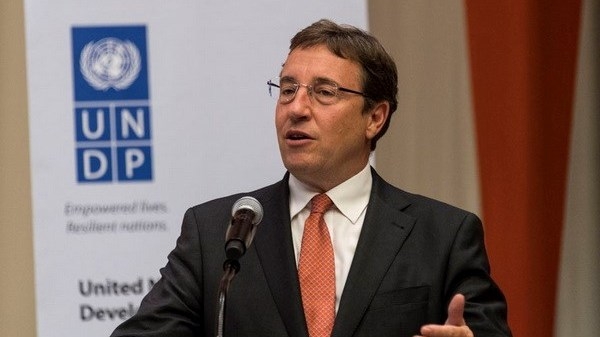United Nations, UN Development Programme Administrator Achim Steiner says that he is “simply in awe” of how India is proceeding on its “fascinating journey” towards meeting its sustainable development goals (SDGs).
It was “mind boggling” how India had lifted 271 million people out of poverty in the 2006-16 decade, he said on Tuesday at a special event, “From Commitment to Achievement: India’s Experience in Localising the SDGs”, held during the High Level Political Forum on Sustainable Development here.
The SDGs are a set of 17 goals for holistic development adopted by world leaders at the UN in 2015 and are to be achieved by 2030. The goals range from poverty elimination and reducing inequalities to providing health services and education for all and climate action.
Steiner cited the success of Aadhaar biometric programme that links millions of people to financial institutions and said he wondered why the world was not studying it.
He also spoke highly of India’s projects like eVIN (Electronic Vaccine Intelligence Network) that helps deliver immunisation to the last mile by digitising vaccine stock data and monitoring the temperature through a smartphone application that were being exported to other countries.
A report “Localising SDGs: Early Lessons from India 2019”, could be a roadmap for other countries on how they can implement the goals at the local levels, it was said.
India’s Permanent Representative Syed Akbaruddin said that robust economic growth is necessary for meeting the SDGs in order to fund the development programmes required for it and provide employment.
India is on a trajectory to meet these goals and it has a strong belief in its capacity to implement the SDGs, he added.
Niti Ayog Vice Chairperson Rajiv Kumar quoted Prime Minister Narendra Modi’s dictum: “If India fails the world fails in achieving the SDGs”, and said that this was a daunting challenge for the nation.
With India’s 1.4 billion people, the nation is so diverse it is like 29 countries put together and the aspirations of its youth are “touching the sky”, he added.
But India was on the “cusp” of major breakthrough in development, he said. An important thrust of India’s development programmes was to reach out and lift the people at the bottom of the pyramid, he said.
India does not admit that development and sustainability are mutually exclusive, he said. Its strategy for reaching the SDGs was based on a convergence of development, sustainability and inclusion.
The three elements driving the development strategy were competitive federalism, cooperative federalism and monitoring, he said.
Competitive federalism gives states an impetus to match achievements, while cooperative federalism scales up successes in an area to make it adaptable elsewhere, he said.
The SDG India Dashboard monitors the progress on achieving the SDGs, he said.
The SDG Dashboard is an analytical tool that looks at 306 indicators to evaluate how different areas of India are performing in working towards the SDG goals and can provide information below the sub-national level down to the districts and panchayats.
The central budget has introduced a performance component that ties future allocations to results, Kumar said.
Later answering a question from the audience about Bihar, Uttar Pradesh and Assam being behind the rest of India in achieving SDGs, he said that India was cognisant of “emerging north-south divide” in development within country. It will not allow such a divide to develop and was introducing measures to ensure the growth of the areas that were lagging behind, he said.
To help the areas that are behind to catch up, 112 most backward districts have been selected for special attention to bring them to the national level, he said.
“Competitive populism” was giving way to “competitive development” and this would help those states develop, he said.
Niti Aayog Adviser Sanyukta Samaddar said that Modi has called for innovative, technology-driven development and India can be the laboratory for developing such strategies.
All of India’s flagship programmes like Ayushman for doubling farmers’ income and Poshan for promoting nutrition were aligned with the SDGs, she said.
Source: ET
Image Courtesy: Nhan
You may also like
-
Trade Connect E-platform For Exports Is Single Window, Fast, Accessible And Transformational: Shri Piyush Goyal
-
Dot Simplifies Approval Processes For Telecom Licenses And Wireless Equipment
-
Coal Production and Supply Trends on Positive Trajectory
-
Union Minister To Release Booklets On Promotion Of Indigenous Species & Conservation Of States Fishes
-
2nd India-Japan Finance Dialogue held in Tokyo on 6th September, 2024
